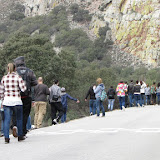- Dirección General de Educación Superior y Liderazgo (Vicepresidencia Segunda y Consejería de Economía Comercio e Innovación de la Junta de Extremadura)
- Vicerrectorado de Estudiantes y Empleo (Universidad de Extremadura)
- Consejo de Alumnos de la Facultad de Estudios Empresariales y Turismo
On Friday there were over 50 of us, who had the opportunity to visit the FIO fair. We then went on on a guided tour of the national park. Our excellent guide, Jaime, took us to the Peñafalcón view point where we could watch Griffon vultures galore, but also a very active Peregrine and even a Spanish Imperial Eagle, though it soon vanished behind the massive cliff across the river Tagus.
A pair of Black stork was apparently waiting for us, for there they were, at ease, on a rock top nearer the waters of the Tagus.
At the Tajadilla viewpoint we had lunch and there it was, awaiting also on the top rock, as crowning the cliff, a proud Egyptian vulture, overlooking the visitors of the park, across the tributary of the Tagus, the river Tiétar, roaring with the rushing waters let from the revervoir nearby. Our friends, the Azzure-winged magpies had also part of our lunch, and some keen photographer took one nice shot of one of them. Below, on the river bank across, a few cormorants were drying their feathers or diving into the light brown waters seeking fish.
Then we followed the winding road and over the damm to the La Báscula viewpoint, where Jaime explained about Black vulture nests on cork oaks.
But the route would bring further amazing sights. Apart from the not few Red deer does seen from the coach, we had a remarkable sight of a pair of Egyptian vultures perching on dry branches of an old tree. And only but a few hundred metres away a pair Black vultures, one on the nest, the other nearby on guard. Beautiful. And all this from just the vantage point over the Tiétar at the La higuerilla ("the little fig tree") viewpoint.
Back to the coach we still had the time to see another pair!!! of Black storks on their nest on a rocky ledge by the waters of the Tiétar.
We finished with an incredible sight of the amazingly beautiful Blue rock thrush, a sight that made for the much missed Eagle owl, elusive this year even for the more skilled and experienced birdwathers around.
On Saturday we started the route earlier because the weather outlook was far from promising. We were over a score and a half. A more reasonable number for birdwatching. The route was the same but the gloomy and windy day seemed to bear down on the birds, that did not show up in the variety and numbers of the day before. Yet, a few of us had the luck to watch a neat sighting of a Bonelli's eagle, flying along the La Tajadilla cliff.
We went back sooner because the Xynthia gusts had made the authorities close the fair for the day. Most of the pavilions uphill in Villarreal had been blown down by the wind. Fortunately, our fellow students working in the main exhibition area were safe and safe we all got back to Cáceres city.
Those who attended the stall of our Faculty of Business Studies and Tourism on Sunday found everything in place the next day. The FIO opended regularly and lots of people poured in eager to visit and see the exhibits. I also called in to see our students and have my own third route of Monfragüe in three days. The day even had some sunny spells, and the crows at La Higuerilla of Saturday had left, to the advantage of the pair of Egyptian vultures, that were back, giving company to the breeding pair of Black vultures.
 |
| FIO 2010 |
This is our fifth year at the FIO in Monfragüe and as always it has been a pleasure to count with scores of enthusiastic students trying to learn about the manifold opportunities that nature can offer as regards sustainable tourism activities. Thank you all so much.
Jesús


